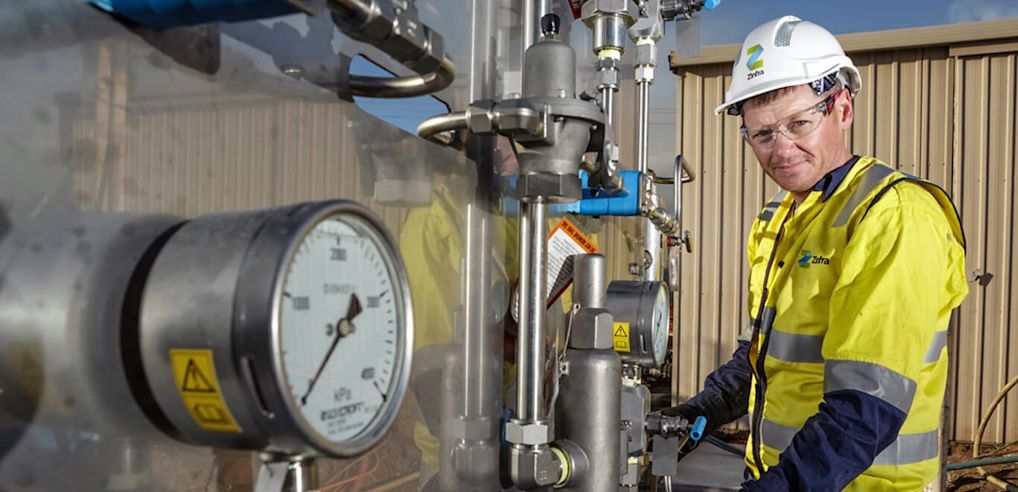With more than three billion tonnes of iron ore identified at the site, FMG needed an experienced and flexible working partner to help realise the location’s unique potential.
FMG’s power infrastructure project manager Graham Martin said Zinfra was selected because of their experience in HV installations up to 300kV and for its large base of resources Australia-wide.
“Zinfra had been shortlisted along with two or three other potential contractors," Mr Martin said. "However in my own experience in the power industry, I’d come across Zinfra and its employees and I’d always found them a positive organisation to deal with."
The power infrastructure designed and built by Zinfra at Solomon will power two ore processing facilities, crushing hubs, overland conveyors and a stockyard and train load-out facility.
The complex $40 million power project took 11 months to complete and included the construction of highvoltage overhead and underground transmission lines and distribution lines. The design, supply, installation and construction of three 132 kV substations was also completed by Zinfra, as a subcontractor to GE. Specifically, the power transmission and distribution infrastructure involved the construction and installation of:
177 poles
54km of conductor
10km of underground cable
8km of fibre optic cable
20km of conduit and a yard full of pipes and valves for the power stations
3 x 11/132 kV 65MVA transformers
2 x 132/33 kV 50MVA transformers
8 x 132 kV outdoor 3 pole circuit breakers
16 x 132 kV outdoor motorised isolators
SUB001 in a breaker and half arrangement
14 x 33 kV indoor GIS switchgears 2
Overhead and underground transmission and distribution lines
The scope of this element of the project changed a number of times due to the changing and rapid development of the mine site. Zinfra engaged leading engineering firm Sinclair Knight Merz (SKM) to complete the detailed design works for the transmission lines. Together with FMG, all teams partnered together to resolve scope changes and issues as they arose.
The design work included both the line design and also the poles, which had to be specially fabricated to cater for the hilly terrain, poor soil conditions and cyclone ratings of the area. Not suprisingly, a key challenge was to ensure the robustness of the finished infrastructure to maximise the reliability of the network, as any loss of supply would have an immediate impact on the output of the mine operation.
Substations
The substation component of the project required an innovative approach to design and construction methodologies to ensure it was delivered within a tight timeframe to meet critical mine production targets. Though a challenging deadline, Zinfra managed the design and construction activities to ensure the works remained on target.
Stakeholder management was critical to this success and with that in mind, Zinfra developed a Design Basis document, which captured the reference standards, assumptions, calculations and basis of designs.
This Design Basis review and approval document was further enhanced by bringing together the various design stakeholders from both Zinfra and the client to work from one location. This served the dual purpose of reducing overall risk through the benefit of close and regular communication and expedition of the approval process for design and construction.
Safety in design was also a high-priority in this project. Safety checks were followed at design input and output stages and hazard and operability reviews were carried out during design milestone periods.
To further assist in meeting tight deadlines, Zinfra also increased its inhouse design resources and the number of resources on site so works on three substations could happen in parallel. As a result, deadlines were not only met, but the project was also delivered with zero safety incidents.
Overall project milestone
A significant milestone for the project was the achievement of the first commercial power distribution to the stockyard, which allowed iron ore to be transported from the mine for commercial purposes. This milestone was achieved on time on December 1, 2012.
Zinfra Group managing director Tony Beach said FMG made particular mention of the project team’s aptitude for leadership, performance, safety and quality. “There was a general ‘can do’ attitude to delivering the project by the Zinfra team, which peaked at around 80 people from around the country,” Mr Beach said.
Challenging location
Describing the Pilbara location as remote is an understatement. The dry and thinlypopulated location was made even more challenging by extreme weather conditions, which led to bushfires, cyclones, storms, flooding and 50-degree days.
The project team managed a committed, fly-in fly-out site team, being conscious of the lifestyle pressures associated with long days and stretches away from family.
“The focus was always on responsibly managing the workers’ roster and ensuring they were well educated to manage heat stress and fatigue," Mr Beach said. "Our people and contractors had to work through the extreme nature of the project by keeping focused and looking after each other."
“We have had a positive safety outcome and an excellent safety culture which has been greatly appreciated by the client.” FMG’s project director for the Solomon Mine Simon Carter said the project was one of FMG’s most important to date.
The Solomon project is the biggest greenfield iron ore project in Australia and potentially the world, with Mr Carter acknowledging the mine will go from producing zero to 60 million tonnes per annum in a little more than two years from breaking ground.
"For such a significant development, we needed contractors who could deliver. Zinfra was one of our key contractors," he said. Their site management was exceptional, the crews were engaged, positive, and flexible and we really valued their input into the project.”

